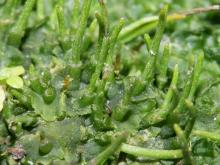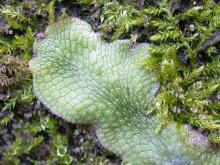Mosses, Liverworts, and Lichens
Media

Species Types
Scientific Name
4 species in Missouri
Description
With their flattened, green forms, hornworts resemble liverworts, but their spore-bearing structures are elongated and horn-shaped. As with liverworts and mosses, hornworts make forest floors, streamsides, and spring openings beautiful.
Media

Species Types
Scientific Name
About 112 species in Missouri
Description
Liverworts, along with mosses, make forest floors, streamsides, and spring openings beautiful. They’re fascinating but overlooked.
Media

Species Types
Scientific Name
Frullania eboracensis
Description
New York scalewort is the most common and easily recognized leafy or scaly liverwort. It forms tiny, delicate traceries on tree bark and is usually rusty or purplish red or green.
Media

Species Types
Scientific Name
Porella spp.
Description
Porella liverworts are fairly common in Missouri, but few people recognize them when they see one. These scaleworts are some of our many species of leafy liverworts — small, mosslike plants that form traceries on rocks or trees.
See Also
About Mosses, Liverworts, and Lichens in Missouri
Mosses, liverworts, hornworts, and lichens seem rather similar, but these organisms are in very different groups. Mosses, liverworts, and hornworts are small, low plants usually found in damp habitats. Unlike more familiar plants, they lack veinlike structures and do not produce flowers or seeds — instead, they produce spores. Meanwhile, lichens are not plants at all: they are a collection of different fungi that have photosynthetic algae living within their tissues.





















